Stretching the hip flexors is not always a good idea
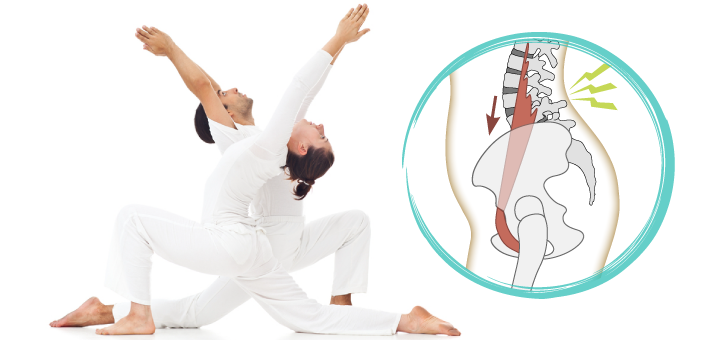
Technically, we have five main hip flexor muscles, but one of them seems to be in the spotlight much more than others – the “mighty psoas.” Psoas seems to be one of the most popular muscles; it’s been the subject of countless articles and several books, and I wouldn’t be surprised if there is a song about it somewhere out there. It has many nicknames: “opinionated psoas,” the “hidden prankster,” the “great pretender,” and many others. It’s been claimed that the psoas is vital for physical, emotional, and spiritual well-being. This love affair resulted in countless suggestions on how to access and stretch the psoas, which commonly boils down to a lunge of some sort. The question is, though – is it always appropriate to stretch a tight psoas? And is there a difference between psoas stretching and releasing? Let’s explore.
The reason psoas is so popular is because it has many important duties. On the structural level, it is responsible for stabilizing the spine and flexing the hip. It also assists in rotating the hip outward and adducting it (moving it toward the midline). One of the most significant things about it is that it connects the legs to the spine, which means that what you do with your legs might affect your spine.
The fact that psoas has so many duties means that it can become overworked and tight.
We tend to think of the psoas as a villain because tight psoas can pull the spine out of alignment. But it can also become a victim. It works best if it has help from the muscles at the front and the back of the torso to keep the body properly aligned, especially when it comes to maintaining the integrity of the spinal curves. If those surrounding muscles get tight and pull the pelvis out of place, this can put unnecessary stress on the psoas and impede its function.
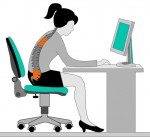
Let’s say you sit all day, placing your body in an unfavorable position. As a result, your buttocks and your rectus abdominis will get tight, facilitating the backward tilt of the pelvis. Then you get up and go to the gym, where you work on 6-pack abs and “buns of steel,” which will only perpetuate the same pattern. Yes, it is useful to work on your core strength, but abdominal crunches won’t get you there. And yes, it’s important to keep your buttocks strong, but too much “steel” back there – in the form of short, tight muscles – will limit the range of motion in your hips and will cause your lower back and your knees to compensate.
This means that the psoas will contract in its attempt to stabilize the pelvis against the pull of the buttocks and rectus abdominis. Now, if you start stretching the psoas and do get it loosened up, it means that the buttocks and rectus abdominis will be free to continue pulling the pelvis out of place and contract even more, which, in turn, will put more stress on the psoas. See the vicious cycle? The solution here would be to release tension in the glutes and abdominals first before attempting psoas stretching. Even simple movements like this can do the trick:
Or, let’s say your lower back gets tight pretty easily (indicating some shortening of the erector spinae muscles). Couple that with thigh tightness and weak abdominals (which also can happen if you sit a lot), and your pelvis will tip forward, exaggerating your lumbar curve.
This type of positioning will create a strong pull on the psoas, which means that it will become stressed and fatigued easily. Stretching an already pulled and stressed muscle is not the best idea. It makes much more sense to gently contract it first to increase the blood flow to the area, then relax it and only then try to loosen it up, if necessary (read more about Contract-Relax-Stretch principle).
Whatever postural imbalances we develop, the psoas is literally caught in the middle. So it is useful to figure out first if your pelvis has a tendency to tip forward or back, and then work on releasing the offending muscles before tackling the psoas.
Another issue that is commonly missed is that the psoas has a partner in crime – iliacus. They pretty much do the same thing and share a common tendon at the attachment point at the leg, but the iliacus originates at the pelvis instead of the spine. Iliacus can be a bit harder to access than psoas, but it’s worth trying because sometimes it will be the root of the problem, not its buddy, the psoas. It’s actually pretty easy to figure out who is the troublemaker. If you ever experience discomfort on the inside of the hip bone and it intensifies when you attempt to stretch the psoas, you’ll know that it’s a tight iliacus. Iliacus does not have the same track record of pulling the spine out of alignment, but it, too, is affected by imbalances in the supporting musculature.
If you choose to work with the iliacus directly, you can try some variations of the following movements:
Of course, all of the above becomes even more complicated because we have a pair of each one of those muscles. It means that the two sides might not develop or tighten in a symmetrical fashion, which will promote further instability and misalignment. The trick here would be to identify how one side is different from the other and then work with the two sides separately and maybe in a slightly different way. If you don’t feel confident in how to proceed with that, it’s best if you seek help from a qualified yoga therapist.
The bottom line is this – if you’ve been running or sitting for a while, don’t get up and go straight for psoas stretching – it might be destabilizing and ineffective. Instead, begin by loosening up the supportive musculature. Often, contracting the psoas will be more effective in releasing tension than stretching. Also, remember that it might be the iliacus that’s causing the problem, so make sure to attend to its needs as well.
Here is an example of a yoga practice for the psoas and iliacus (sequence and video). Check it out!
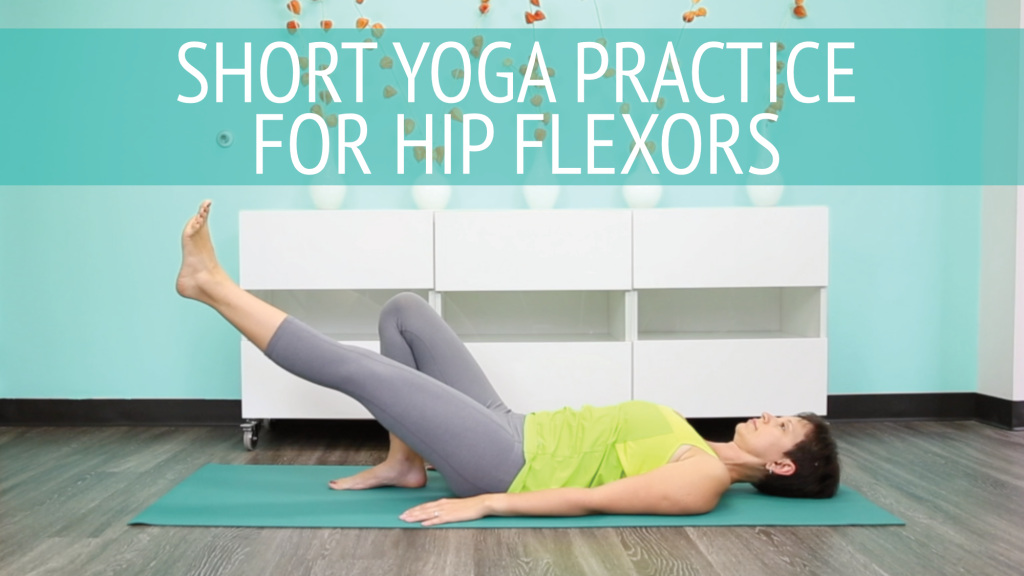
This short yoga practice is meant to loosen up your hips by contracting and stretching your hip flexors. This can have a positive effect on your lower back as well, since hip flexor tightness is often connected to lower back pain.

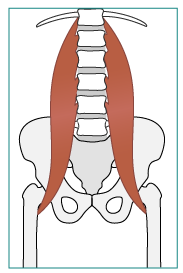
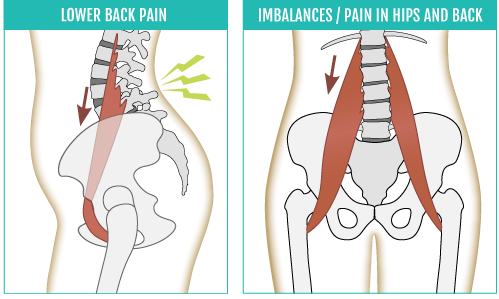
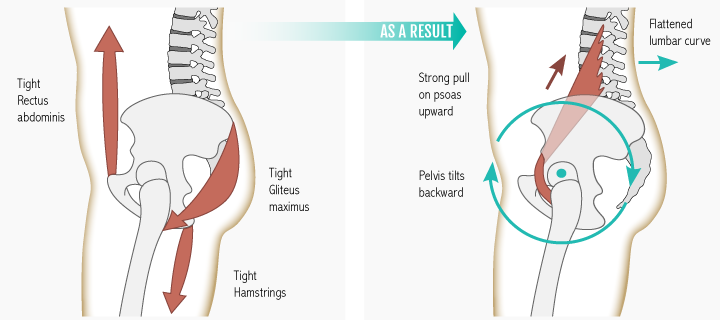

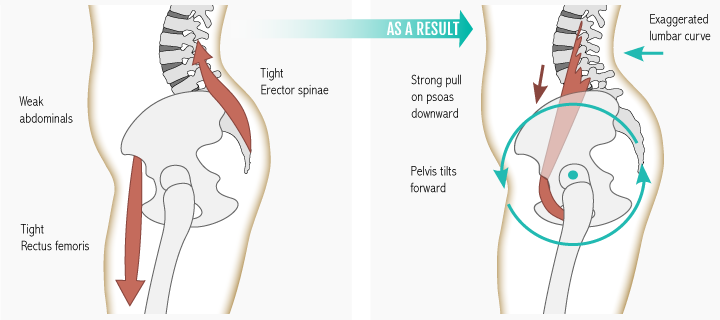
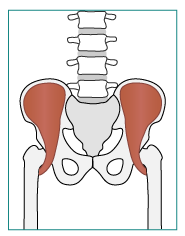
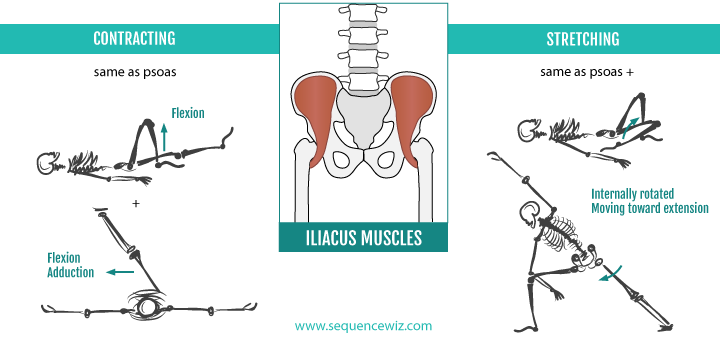
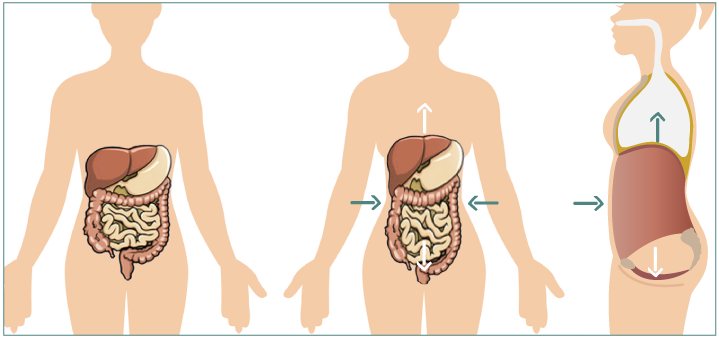

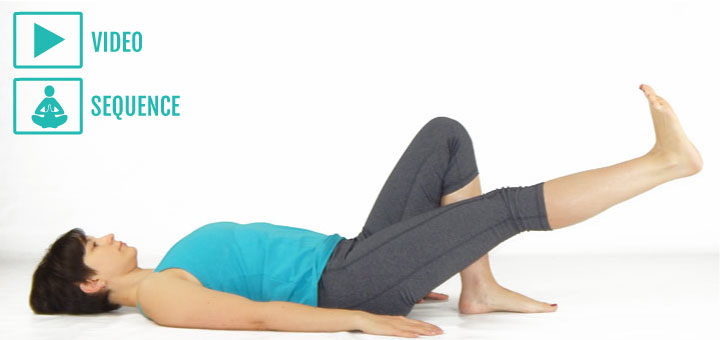
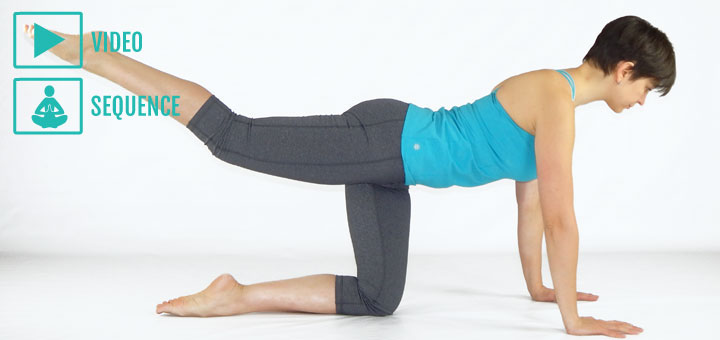






Hi Olga –
As always, thanks for the beautiful and well thought out article. One question. How does the gluteus maximus (I assume that is what you are referring to by ‘buttocks’) get tight from too much sitting? My understanding is that too much sitting weakens the gluteus maximus because the hips remain in a state of flexion as we sit, thus pulling the gm into a stretch. Unless you are referring to tightness due to compensation for that weakness? If so, it would be helpful to be specific with that description. Thanks!
Mado
Hi Mado, thank you for your question! “Tight” and “weak” are not mutually exclusive, so your glutes can be tight and weak at the same time. Any time you tilt your pelvis backward, you are shortening your posterior muscles (gluteus maximus and hamstrings). Try that for yourself – stand with your hands on your hips and tip the top of the pelvis back. Notice how your glutes shorten. When you sit with the tailbone tucked under, as many of us do, it may cause your glutes to shorten (that’s what I meant by “tighten”). In addition, some of us are in a habit of clenching our butts when we sit, which doesn’t help either. Does that make sense?
The glutes are the antagonists to the psoas.. If your psoas is tight and short from sitting all day, it can prevent the gluteals from firing and so they do need to be strengthened. Ever notice how many yoginis have flat butts?
I think that the glutes and the erector spinae in most people are not short and tight at all .They are weak and stretched out and the Bird -dog ( all fours pose) is very important because the glutes and the back muscles engage, which takes pressure off the flexors in the anterior.
Sitting all day with the chair back doing the work of the back muscles and glutes is the bane of our modern lifestyle.
Psoas muscles need to do eccentric contractions so that they are strong but in a lengthened way. To keep the psoas from being strained from weak glutes and hamstrings, one should always bend the knees very deeply in all forward bends so that the gluteals and hamstrings can engage. ( they work together) The straight knee forward bends that dominate yoga shorten the psoas and weaken and strain the gluteal and hamstring muscles.
What most people do not realize is that stretching a sore back or butt is a band-aid. The psoas and other flexors in the anterior body are short from being in chairs. So back and butt muscles are not tight, they are strained and stretched out and they need to be engaged and shortened to take pressure off the psoas.
I agree that most abdominal exercises just create more problems as the trunk muscles and psoas get wired predominately as flexors when their most important function should be spine and trunk stabilization.
Many yogis have very flat butts and sacral platform because of those constant forward bends. As the sacral ligaments loosen, this puts all of the muscles in the hip joint into delinquent functions they are not designed to do.
I created YogAlign over 20 years ago to have a yoga system that is about aligning not contorting. We all need to be very careful about the positions we use in our yoga practice. Ideally all poses should simulate natural anatomical function. Start by dropping the straight knee forward bends. Just try walking without bending your knees and it will become very apparent why we should not stretch the tensional forces that provide the spring and shock absorption needed for a pain-free body.
Excellent and informative post, so many others are teaching others bad habits!
I was stretching my right side psoas so much that now i have a long bulge in front on my right groin. How can I get rid of it.?
I have really tight psoas on my right side along with a tight quadratus lumborum. In addition, my right pelvis is tilted forward relative to the right and also hiked up. I also have left cervical scoliosis, right thoracic and right lumber scoliosis. I will try your exercises and will comment back in six months.
Thanks for the very interesting article! I’ve always thought that my psoas muscles are tight and need to be stretched more, but I KNOW that I tend to have an exaggerated lumbar curve, so maybe they are already over-stretched? If so, what types of practices/poses would you recommend for this? Thank you!
Hi Beth! The fact that your lumbar curve is exaggerated doesn’t automatically mean that your psoas is over-stretched (or tight, for that matter). As always with the body – there are so many variables 🙂 The question is – why do you think that your psoas is tight? Does it hurt? Does it restrict you in some positions? You can try the practice that I have here and notice how #3b and #11b feel to you. Do they feel like psoas is strong enough? It’s usually about the balance between different parts, and since you mentioned exaggerated lumbar curve, core strengthening might be more important.
Olga, thank you so much for you response (and I should also mention that I love this site)!
No, my psoas does not hurt. I have assumed that it is tight because 1) I sit a lot (I’m a psychologist, so my job is mainly sitting talking to clients, and I commute 1 1/2 hours total per day), and 2) I had a bad episode of low back pain several years ago, and my massage therapist suggested that a tight psoas might be a contributing factor.
I definitely want to try this practice and will pay attention to see if I notice any restrictions in the particular postures you mention. On the one hand, I DO feel like I have a strong core, but on the other, I wonder if you may be right in that I may have core weaknesses (such as thrusting my rib cage) which are contributing to my lordosis. If you have any other posture suggestions for this, please let me know, and thank you again!
Oh, I see where you are coming from. Sitting and commuting can definitely tighten up the hip flexors. Unfortunately, even if you have a strong core, it’s super hard to maintain good neutral posture if you sit for X number of hours a day. I am sure that you are already doing what you need to be doing to counteract the sitting with activities (like standing and walking breaks, yoga practice, other sort of movement). It sounds like movement in general and especially things like Cobra would be super useful. You can try to squeeze the Magic three poses into your day whenever you can to prevent the recurrence of that lower back episode: http://sequencewiz.org/2014/04/16/magic-three-home-yoga-practice/ It’s the little things that we do often that make all the difference!
Thank you again! Yes, I think you are right that even if my core is strong, sadly, it is probably overwhelmed by my many hours sitting. 🙁 I do exercise daily, including a lot of yoga and other stretching. However, I will definitely try doing more cobras as well as the “Magic 3”! (Luckily, I haven’t had another low back pain episode since the one in 2012, so I guess I am doing something right.)
I want to start stretching & exercising My entire illipsoas (psoas) muscles. BUT…,I want to start it the Right Way.I have read that I must open/stretch the opposing muscles FIRST, or I could do more harm than good.Any good books that will guide Me through this? Please Help.
Hi Olga,
I was diagnosed a constricted psoas (mainly right side) and to rest and stretch it out. But stretching doesnt seem to be helping. In fact my yoga practice (which is very slow now) doesnt seem to be doing much for it. I still have pain in the front hip, and back spasms. Maybe I need to be strengthening instead? I have lordosis, and when i stand for long periods of time, I often get low back pain. I also sit for long hours a day, and I know this was also a cause. 6 months ago, I strained my left knee LCL doing some plyometric jumps, which i also think was directly related to my bad alignment and compensation in other muscles. The knee is still a little funky, and my legs seem to be uneven recently. When I walk, its almost as if there is a lack of sensation in my left leg all the way down to the sole of my foot. Any ideas on exercises that would help me in this situation? Thank you!!
Hi Maria! I would be hesitant to give any simple recommendations to you since you are having nervy pain and lack of sensation – I wouldn’t want to make things worse for you. Have you seen a physical therapist? It might be time. You can also find a qualified yoga therapist in your area and get a consultation: http://www.viniyoga.com/learn-experience/viniyoga-teachers-and-yoga-therapists Hope you feel better soon!
Thank you for an excellent informative article!
Hi Olga, and thank you for a nice article!
I have been having pain in my front of my hip, towards the groin, which seams to get worse by sitting for extended hours. I have an office job, so basically I sit all day. However, I have been an active cyclist and the pain started suddenly at a spinning class. That`s 6 months since now, and the pain has not become better despite strengthening excercises for the whole hip area, as well as stretching, every day since the episode. My physiotherapist thinks its the pectineus muscle as well as the psoas/illipsoas that`s too tight, and I too feel that it`s too tight when I strech that area on the injured side. Anyway, it seams to have developed into a internal snapping hip problem, and the pain is not improving. Any suggestions on excercises? And should I continue streching?
Hi Eva and Olga,
I have recently begun experiencing similar pain, and I too sit a lot for my job and cycle as a form of exercise. I got some hip/groin pain started this way a couple of months ago, and have been alternately told that I have arthritis (i’m 26!) torn labrum (onset of pain doesn’t fit this diagnosis), tight psoas, loose psoas, and all the rest. Very difficult to choose a treatment strategy.
I’m curious, how did you address your pain, I hope you found some relief!
Hello
I have been in a wheelchair for four years now after a car acident left me with spine trama. In the last two years I have been slowly regaining strenght and am now walking with help from walker. I would like to move on from the walker and have the strength but siting in the wheelchair left my hip flexors short and exstremly tight and butt muscles weak. I have been able to regain gluteus strength and length in my hip flexsors. When i first regained enough strength to stand my butt protruded and I couldnd straighten I bent forward the pelvis forward and my low back bent in. After strength and physical therapy focusing on my gluteus, thigh abductors and adductors and hip flexors I stand much better but cant seem to lengthen my flexors or strengthen my gluteus enough to stand with my pelvis in the correct position.it still wont align straight and my back spasms from straining to “tuck” my pelvis and stand straight.
My question is, should I work more on strengthening my gluteus or stretch? After i stretch i stand on my knees to see if I can get my hip to straighten. I also try and walk on my knees and cant. I barely seem to have the strength to move a knee forward but i know Im strong enough so is it because of tight flexors? and if i do i loose balence.
So if you have any sugestions i would appreciate the help. Thankyou. William C
Question. I have a flat back, very shallow lumbar curve. It doesn’t seem like I need to stretch my psoas. It seems like I should work on psoas toning muscles. Is this correct and what can I do to tone my psoas?
Yikes, i’m sti working on this. Thanks
Hi, I am a paraplegic that has been sitting for 16 1/2 years. Their are not many stretches that I can do to have keep my psoas loose. I do sleep on my stomach sometimes and lay at the edge of my bed and let my legs hang but I have been like this for so long I don’t think I can get looser from stretching. My hips are tilted so far forward that my back is bent in. But strangely I do not have any back pain at all. Is their some sort of surgery to maybe cut or stretch these out?
I have a problem and I’m not sure what I should do. I have done a lot of yoga in the past, i’m very flexible and I am an athlete so I’m in very good shape. Today I started getting a sharp pain in my left hip area and lower back on the left side. It kept increasingly tightening and Tonight I
can hardly walk or move now without an intense pain what type of what exercises do you recommend? Should I go to a chiropractor or an acupuncturist or yoga therapist what do you recommend? I haven’t been lifting weights for at least six days so this cannot be the problem.What do you advise?
Is there anything you can do that isn’t 56 minutes?